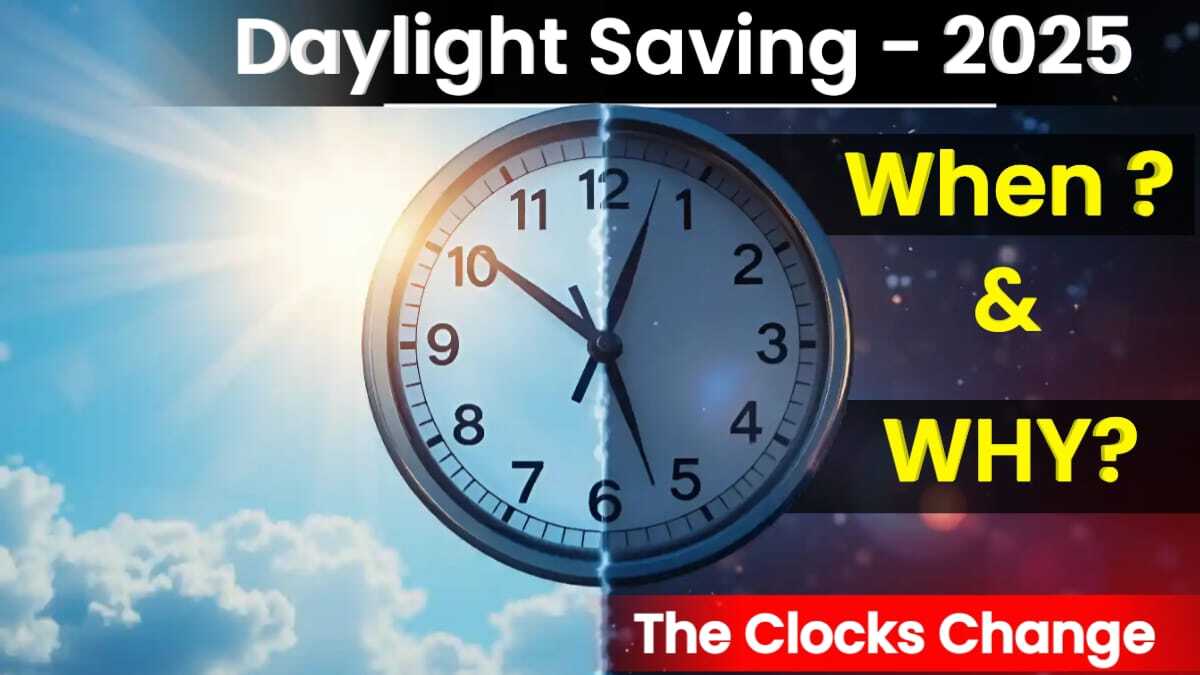Daylight Saving Time (DST) is an annual practice that shifts the clock forward by one hour during warmer months to extend daylight hours in the evening. This adjustment aims to make better use of natural light, conserve energy, and enhance productivity. However, not all countries observe DST and the practice remains a topic of debate worldwide. In 2025, several nations including the United States, Canada, and parts of Europe will adjust their clocks to follow DST. This Artical provides essential details on when and where DST will be observed and how to prepare for the time change.
Daylight Saving Time (DST)
Daylight Saving Time is a system of adjusting the clocks forward by one hour during warmer months to extend evening daylight. It is primarily used to conserve energy and make better use of natural daylight. The term is often implemented by “spring forward” in the spring and “fall back in the fall to return to standard time.
Daylight Saving Time will last until Sunday, November 2, 2025, at 2:00 AM local time, when clocks will fall back by one hour. This marks the return to standard time for many regions.
Start Date of Daylight Saving Time in 2025
Daylight Saving Time (DST) in the United States will begin on Sunday, March 9, 2025, at 2:00 AM local time. At that moment clocks will spring forward by one hour meaning we will lose an hour of sleep but gain an extra hour of daylight in the evening. some countries have abolished the practice due to inefficiency or minimal energy savings.
Countries Observing Daylight Saving Time in 2025
Several countries worldwide continue to follow DST. These include the United States, Canada, Mexico (in select regions), the United Kingdom, most European nations, Australia (in some states), and parts of South America and the Middle East. However, some countries have abolished the practice due to inefficiency or minimal energy savings.
Countries Following Daylight Saving Time in 2025
North America
- United States – DST begins on March 9, 2025, at 2:00 AM and ends on November 2, 2025, at 2:00 AM. Most states follow DST, except Hawaii and parts of Arizona. Some states, like Florida and California, have proposed making DST permanent.
- Canada – Observed in most provinces and territories, with DST starting on March 9, 2025, and ending on November 2, 2025. Saskatchewan and some regions do not observe DST.
- Mexico – Only northern border municipalities observe DST, starting on March 9, 2025, and ending on November 2, 2025. The rest of Mexico abolished DST in 2022.
Europe
- United Kingdom – Follows the EU’s DST schedule. Clocks will move forward on March 30, 2025, at 1:00 AM GMT and back on October 26, 2025, at 2:00 AM GMT.
- Germany – As part of the European Union, Germany follows the same DST period as the UK, beginning on March 30, 2025, and ending on October 26, 2025.
- France – Observes DST along with the rest of the European Union, adjusting clocks forward in March and back in October.
- Spain – Follows the EU DST schedule, with the time change occurring on the last Sunday of March and October.
- Italy – Similar to other EU countries, Italy observes DST from the last Sunday in March to the last Sunday in October.
Oceania
- Australia – DST is observed in New South Wales, Victoria, South Australia, and Tasmania, starting on October 6, 2024, and ending on April 6, 2025.
- New Zealand – DST begins on September 29, 2024, and ends on April 6, 2025.
South America
- Chile – DST is typically observed, but changes depend on government policies. Generally, DST starts in September and ends in April.
- Paraguay – Follows a similar DST schedule to North America, with DST beginning in October 2024 and ending in March 2025.
Middle East
- Lebanon – Observes DST to align with European and regional time adjustments, typically starting in March and ending in October.
- Israel – Implements DST from March 28, 2025, to October 26, 2025.
Adjusting to the Time Change
- Gradually shift your sleep schedule: by going to bed earlier a few days before the transition.
- Increase morning light: exposure to help your internal clock adjust naturally.
- Reduce screen exposure: improve sleep quality.
- Regular physical activity: can help you adjust faster to a time change. Try to exercise in the afternoon, as this can help you feel more alert during the day and sleep better at night.
- Modify Meal Times: Adjust your meal schedule to gradually align with the new time zone. Begin having meals at the adjusted times (e.g., eating dinner earlier or later by 15-30 minutes each day). This helps your body sync up to the new routine and minimizes digestive disruptions.
Future of Daylight Saving Time
Discussions continue about whether DST should become a permanent fixture. The Sunshine Protection Act, which aims to establish DST year-round, has been proposed in Congress, though no final decision has been reached.
Final Thoughts
Daylight Saving Time 2025 will once again bring the familiar time change routine. Whether you appreciate the extended daylight hours or find the adjustment challenging, staying informed and prepared will make the transition smoother.
FAQs
Q1.When does Daylight Saving Time start in 2025?
Daylight Saving Time in the United States begins on Sunday, March 9, 2025, at 2:00 AM local time. At this moment, clocks will move forward by one hour.
Q2.Does everyone in the U.S. follow Daylight Saving Time?
No, not all U.S. states observe DST. Hawaii and most of Arizona do not follow DST, though other states, such as Florida and California, have proposed making DST permanent.
Q3.When does Daylight Saving Time end in 2025?
Daylight Saving Time in the United States ends on Sunday, November 2, 2025, at 2:00 AM local time, when clocks will “fall back” by one hour, returning to standard time.
Q4.How can I get ready for the upcoming Daylight Saving Time change?
You can get ready for the time change by gradually shifting your sleep schedule, sticking to consistent daily routines, and making sure your sleep environment is cozy and conducive to rest.
Q5.Which states in the U.S. do not observe Daylight Saving Time?
Hawaii and most parts of Arizona do not observe Daylight Saving Time.

